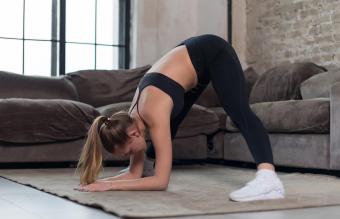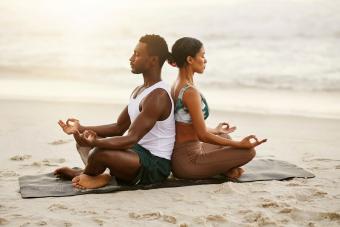
If you practice yoga, you may have noticed that many yoga poses (asanas) have animal names. From cat-cow to cobra to downward dog, it seems ancient yogis were inspired by the animal kingdom and valued the lessons these creatures can teach.
Whether you're looking to channel the strength and courage of a tiger or embody the stamina of a camel, read on to learn some of the most popular yoga poses with animal names.
The History of Animal Yoga Poses
Yoga poses with animal names are deeply rooted in the history of yoga, and animal asanas can be found throughout classic yoga texts. The lion, rooster and peacock can be found in the Sanskrit manual Hatha Yoga Pradipika written in the 15th century. More animal poses are mentioned in the 17th-century text Gheranda Samhita.
It is believed that yoga poses named after animals are not only modeled after the movements these animals make, but are meant to encourage yogis to embody the characteristics of that animal. Take the camel pose, for example. Camels symbolize stamina, self-sufficiency and survival. As you stretch into camel pose, you may invoke the adaptability and enduring energy of the camel.
Yoga Poses with Animal Names
Here are some of the most common animal yoga poses and a brief overview of the benefits each asana may have on your health and wellbeing.
Downward Facing Dog
Sanskrit name: Adho Mukha Svanasana
Perhaps the most well-known of all animal-named yoga poses, the downward-facing dog is a staple yoga pose you are likely to practice in many classes. A combination of stretching and strengthening, this pose is excellent for improving balance and flexibility in your body. Downward-facing dog pose can help release tension and stiffness to soothe tired muscles and help improve posture and circulation. This pose can easily be incorporated into a yoga flow series - into sun salutations, for example.

Cat Pose
Sanskrit name: Bidalasana
Cat pose is a foundational yoga pose that is beneficial for beginners and advanced yogis alike. This pose increases spine flexibility and promotes relaxation, especially if you practice deep breathing while moving in and out of the pose. The cat pose engages the core muscles, helping tone back muscles and release tension in the lower back, neck, and hips. Be sure to focus movement in your hips and spine, not your arms, for maximum benefits.

Yoga Fish Pose
Sanskrit name: Matysasana
Fish pose is frequently used in restorative yoga classes, and for good reason. A reclined, back-bending posture, the fish pose helps open the throat, chest, shoulders and abdomen which may help relieve congestion in the nasal passages and help yogis with a cold or allergies breathe a little easier. The abdomen stretch the fish pose requires may help relieve gastrointestinal discomfort and menstrual cramps. This pose may help improve posture due to the deep neck and shoulder stretch it offers.

Cow Face Pose
Sanskrit name: Gomukhasana
Cow face pose is a seated pose that stretches the entire body so that, with a little imagination, the body resembles a cow's face once in position. This pose is excellent for improving posture and helps counteract the effects of sitting for long periods of time by giving a deep stretch to the shoulders, glutes and quadriceps. Cow face pose helps open the shoulders and hips and is often incorporated into flow yoga sequences.

Cobra Pose
Sanskrit name: Bhujangasana
The cobra pose is a chest-opening backbend that stretches the entire back and upper body. Excellent for relieving back pain, shoulder tension, and upper body soreness, this pose is often incorporated into yoga classes as a warm-up or leading up to more intense back-bending poses. Cobra pose helps boost energy, relieve stress, and can help improve your posture. If you've been sitting slouched over your desk all day, the cobra pose can help improve posture, relieve stress and boost your energy levels.

Camel Pose
Sanskrit name: Ushtrasana
Camel pose is a great pose for stretching the whole front of the body, including abdominal muscles, chest, shoulders and front of the hips and thighs. It's also effective for building strength in the back muscles, hamstrings and glutes. This pose may relieve low back pain and improve spinal mobility. Camel pose is a variation of a backbend, so it may help improve posture. Some yogis believe the camel pose encourages confidence and empowerment.

Tortoise Pose
Sanskrit name: Kurmasana
Tortoise pose is a favorite for many, as it is believed to help bring your attention within yourself to help quiet the mind and promote inner peace. This pose is associated with strengthening the back, promoting flexibility in the hips and toning abdominal muscles. This pose can be difficult for beginners, as it requires some flexibility to pin down your arms and legs while curving your back to appear as a "shell". Practice patience with yourself as you slowly make your way into the pose.
Pigeon Pose
Sanskrit name: Rajakapotasana
Pigeon pose is a sitting pose that stretches and opens the hips to increase flexibility and mobility in the hip joints. It also helps stretch the lower back muscles and may help relieve back and hip pain caused by prolonged sitting. The pigeon pose can help prepare the body for seated poses and backbends, but may be challenging if you have tightness in your hips or back, so go slow and do not continue if you feel pain.

Crow Pose
Sanskrit name: Bakasana
An advanced yoga posture, the crow pose requires considerable balance. In this pose, your feet are off the ground and your bodyweight is supported by your arms. Crow pose is beneficial for strengthening the forearms, wrist and abdomen while giving a good stretch to the upper back. If you're afraid of falling while in crow pose, consider practicing variations of the pose until you've built enough strength and confidence to go into this invigorating balancing act.

Peacock Pose
Sanskrit name: Mayurasana
Peacock pose is an advanced hand-balancing pose that requires considerable strength. This pose helps stretch the wrists and strengthens the arms, chest, thighs and core muscles. Though most of your weight will be felt in your wrists and forearms, your core, back and leg muscles are also engaged to stretch and strengthen the whole body. If you stand for hours a day, the peacock pose may offer much-needed relief for your feet and legs.

Eagle Pose
Sanskrit name: Garudasana
The eagle pose is another advanced yoga asana that requires considerable balance and concentration. Executed standing on one foot with the other leg wrapped around the bent knee of the supporting leg, you will intertwine your arms to get into thise pretzel-like pose. Eagle pose helps strengthen your core, inner thighs and leg muscles while stretching the upper back, shoulders and hips.

Scorpion Pose
Sanskrit name: Vrischikasana
Scorpion pose is an advanced yoga pose that some argue is one of the most difficult yoga poses to hold. This pose involves balancing on your lower arms with your legs bent over your body in the air, which requires significant core and shoulder strength. The scorpion pose helps strengthen the arms, core, shoulders and back and improves spinal flexibility and mobility.

Frog Pose
Sanskrit name: Bhekasana
In frog pose, the legs are bent and placed to the sides of the body, much like a frog looks when it's ready to jump. An excellent hip-opener, this pose stretches the inner hips and thighs to improve flexibility and range of motion throughout the lower body. Because it also stretches back muscles, it may help relieve any tension in the lower back and soothe sciatic pain.

Crocodile Pose
Sanskrit name: Makarasana
Crocodile pose is a resting pose known to help release stress and tension. Lying on your stomach with your head resting on your folded arms, this pose is often used at the end of yoga classes to relieve lower back tension and open up the chest and shoulders. This pose may help improve the alignment of the spine and posture since it relaxes back muscles. Some yogis suggest the crocodile pose helps reduce anxiety and promotes good sleep.
Learn More About Animal Yoga Poses
When you move into an animal-named yoga pose, it may be helpful to reflect on the characteristics of that particular animal to connect with those parts of yourself. To learn more about these and other yoga poses (animal-inspired or not!), get tips on specific yoga poses for emotional healing.







